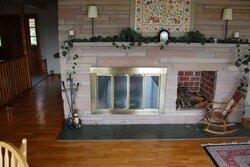Hello and thanks for being here and doing what you do. I've been learning a lot browsing the forum. I have a 1961 house built into a hill so half of the downstairs is basement. It's 2,100 sq.ft., with a natural gas force air furnace. It's also got a big chimney in the middle of the house, with fireplace openings on each level.
We sometimes used the fireplace upstairs, where we spend most of our time, because I love having a fire, but it chills the bedrooms and pollutes the air. I'd like to have a fire without guilt and also be able to heat at least part of the house when the electricity goes out. The fireplace is in a large open living room/dining room/kitchen and there's a hallway leading to the bedrooms. We've been considering an insert for a while, but suddenly my wife is ready to buy. I'm not sure what changed between spring and now, but I'm not questioning it. She wants something flush and contemporary looking. I want something with a large window and good efficiency. We like the looks and efficiency of the Scan DSA4, but I think the window is probably too small. We also like the Morso 5660 without the fan.
Trouble is, the quote we got for the Morso installed and taxed is $4,370. That's $2,750 for the stove, and the rest is surround, install, shipping, and tax. Dang that's a lot of money. There's a tax credit which helps some.
So my questions are:
1. Will the Morso without the fan heat the upstairs okay? How long will it take for a fire to make the large room warm?
2. Is this a reasonable price for the south Puget Sound area?
3. How much could I save by waiting until spring?
There's one other major issue which is that we don't like the surround that they offer. The installer thinks it will take $300 - 400 to make and install a custom surround. I'd like to have something that goes to the edge of the opening, not over the edge, covering it. Any suggestions?
We sometimes used the fireplace upstairs, where we spend most of our time, because I love having a fire, but it chills the bedrooms and pollutes the air. I'd like to have a fire without guilt and also be able to heat at least part of the house when the electricity goes out. The fireplace is in a large open living room/dining room/kitchen and there's a hallway leading to the bedrooms. We've been considering an insert for a while, but suddenly my wife is ready to buy. I'm not sure what changed between spring and now, but I'm not questioning it. She wants something flush and contemporary looking. I want something with a large window and good efficiency. We like the looks and efficiency of the Scan DSA4, but I think the window is probably too small. We also like the Morso 5660 without the fan.
Trouble is, the quote we got for the Morso installed and taxed is $4,370. That's $2,750 for the stove, and the rest is surround, install, shipping, and tax. Dang that's a lot of money. There's a tax credit which helps some.
So my questions are:
1. Will the Morso without the fan heat the upstairs okay? How long will it take for a fire to make the large room warm?
2. Is this a reasonable price for the south Puget Sound area?
3. How much could I save by waiting until spring?
There's one other major issue which is that we don't like the surround that they offer. The installer thinks it will take $300 - 400 to make and install a custom surround. I'd like to have something that goes to the edge of the opening, not over the edge, covering it. Any suggestions?




